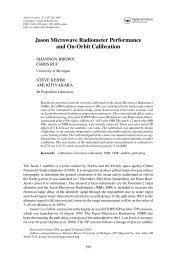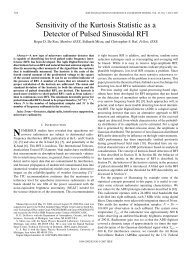windsat retrieval of ocean surface wind speeds in tropical cyclones
windsat retrieval of ocean surface wind speeds in tropical cyclones
windsat retrieval of ocean surface wind speeds in tropical cyclones
You also want an ePaper? Increase the reach of your titles
YUMPU automatically turns print PDFs into web optimized ePapers that Google loves.
Figure 1. W<strong>in</strong>dSat observations <strong>of</strong> Hurricane Katr<strong>in</strong>a <strong>in</strong><br />
Category 3 stage immediately before landfall. Data from 37<br />
GHz V-pol channel for optimal visualization.<br />
Katr<strong>in</strong>a and Rita were both Category 3 storms (<strong>w<strong>in</strong>d</strong>s<br />
between 111 and 130 mph) when observed on 28 August<br />
and 21 September, respectively. Figure 1 illustrates<br />
W<strong>in</strong>dSat’s 37 GHz v-pol observation <strong>of</strong> Katr<strong>in</strong>a dur<strong>in</strong>g the<br />
overpass.<br />
2.2. H*W<strong>in</strong>d analysis<br />
The NOAA-HRD <strong>w<strong>in</strong>d</strong> field analysis is used as “ground<br />
truth” for the <strong>surface</strong> <strong>w<strong>in</strong>d</strong>s. The analysis uses <strong>surface</strong> <strong>w<strong>in</strong>d</strong><br />
data collected with<strong>in</strong> a three to six hour <strong>w<strong>in</strong>d</strong>ow <strong>of</strong> the<br />
satellite overpass from various sources such as buoys, GPS<br />
dropsondes, ship observations and the plane-based Stepped<br />
Frequency Microwave Radiometer (SFMR), among others.<br />
The data are projected to a near <strong>surface</strong> level <strong>of</strong> 10 meters<br />
and then <strong>in</strong>terpolated l<strong>in</strong>early through the H*W<strong>in</strong>d<br />
algorithms to complete a <strong>w<strong>in</strong>d</strong> field representative <strong>of</strong> the<br />
entire cyclone. This approach allows for external quality<br />
control dur<strong>in</strong>g the analysis.<br />
The <strong>w<strong>in</strong>d</strong> field is not a perfect description <strong>of</strong> a<br />
cyclone’s <strong>surface</strong> <strong>w<strong>in</strong>d</strong> <strong>speeds</strong>. The observations are<br />
collected over a large time frame, which does not capture<br />
the quick variability <strong>in</strong> a storm’s <strong>w<strong>in</strong>d</strong> structure. Also, the<br />
averag<strong>in</strong>g necessary to complete the <strong>w<strong>in</strong>d</strong> field can decrease<br />
the result<strong>in</strong>g maximum <strong>w<strong>in</strong>d</strong>s from the true value, and can<br />
<strong>in</strong>troduce errors between 10% and 20% [7]. The analysis<br />
generated for the three cases used <strong>in</strong> this study were<br />
carefully constructed with abundant data samples to best<br />
reduce any errors.<br />
3. EMISSIVITY RETRIEVAL<br />
The <strong>surface</strong> emissivity <strong>retrieval</strong> process is based on the<br />
radiative transfer equation, <strong>of</strong> the form<br />
Figure 2. Integrated liquid water (mm) retrieved from<br />
Hurricane Katr<strong>in</strong>a for atmospheric absorption model.<br />
T B (f,p,) = (f,p,)T surf e -(f)sec + T up (f,)<br />
+ (T down (f,) + T cosmic e -(f)sec ) e -(f)sec (1)<br />
where f is the channel frequency <strong>in</strong> GHz, p is polarization<br />
and is the <strong>in</strong>cidence angle. represents the <strong>surface</strong><br />
emissivity, and is a functional comb<strong>in</strong>ation <strong>of</strong> the<br />
appropriate specular and rough <strong>surface</strong> values depend<strong>in</strong>g on<br />
the <strong>w<strong>in</strong>d</strong>. T surf is the temperature <strong>of</strong> the sea <strong>surface</strong> <strong>in</strong><br />
Kelv<strong>in</strong>. is the optical depth, and is the l<strong>in</strong>k to the<br />
atmospheric clear<strong>in</strong>g model. T up and T down are the upwell<strong>in</strong>g<br />
and downwell<strong>in</strong>g atmospheric brightness temperatures, both<br />
<strong>of</strong> which are latitude dependent and are <strong>in</strong> Kelv<strong>in</strong>. T cosmic is<br />
the background brightness temperature, aga<strong>in</strong> <strong>in</strong> Kelv<strong>in</strong>. <br />
is the <strong>surface</strong> reflectivity. This model was designed by [1],<br />
where<strong>in</strong> details for each parameter are given.<br />
The first atmospheric clear<strong>in</strong>g algorithm was<br />
developed by [3], and retrieves optical depth from the<br />
atmosphere-sensitive high frequency W<strong>in</strong>dSat observations<br />
us<strong>in</strong>g a absorption-based parameterization. The optical<br />
depth is directly related to column <strong>in</strong>tegrated water vapor<br />
(V, cm) and <strong>in</strong>tegrated ra<strong>in</strong> and cloud liquid water (L, mm)<br />
through the form<br />
(f) = c 0 (f) + c 1 (f)V + c 2 (f)L (2)<br />
whose coefficients are given <strong>in</strong> [3]. For this <strong>retrieval</strong>,<br />
<strong>surface</strong> emissivity must also be estimated and is considered<br />
dependent on <strong>w<strong>in</strong>d</strong> speed (W, m/s) alone through the<br />
function<br />
(W) = 0 + a 0 (1-exp[-a 1 W-a 2 W 2 ]) (3)<br />
as described <strong>in</strong> full by [3] and which is based on [8]. The<br />
three parameters (V and L as primary, W as secondary) are<br />
retrieved for the atmosphere by iterat<strong>in</strong>g Equation (1) until<br />
the modeled brightness temperatures have a root-meansquared<br />
(RMS) difference from the W<strong>in</strong>dSat brightness<br />
1832





